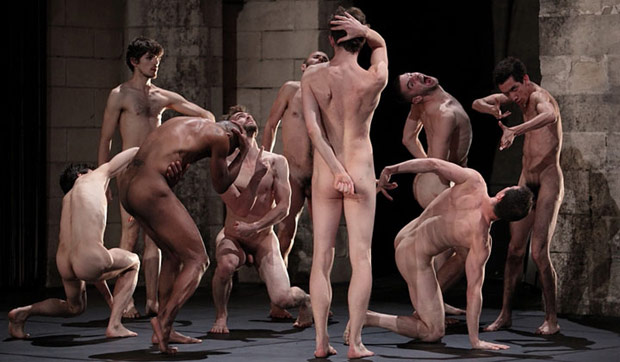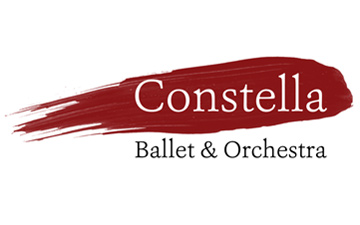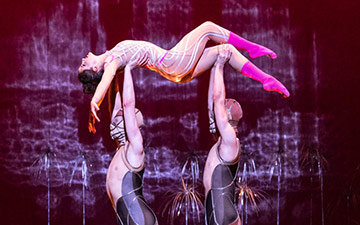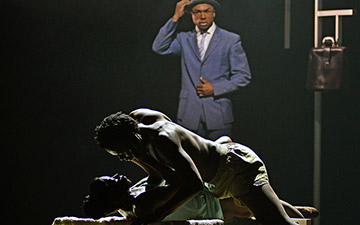
© Francois Stemmer, via Sadler’s Wells.
Oliver Dubois – Ballet Du Nord
Tragédie
London, Sadler’s Wells
8 May 2014
www.balletdunord.fr
www.sadlerswells.com
The tragedy of this dubious affair lay in its mind-numbing tedium. Prior to this show, I would not have believed that 90 minutes spent watching the antics of eighteen naked people could be so dull. I’m clearly not cut out for naturism.
Oliver Dubois’ Tragédie for Ballet du Nord (of which he became artistic director at the start of this year) consists of nine women and nine men on a journey of three uneven sections, beginning with the orderly precision of pacing downstage (facing the audience) and back upstage (facing away) in different combinations (from just a single woman to all 18 performers, taking in what must have been every permutation in between).
They walked in straight lanes, entering and exiting through see-through curtains at the rear. Apparently there was something clever in the fact that each promenade was made in exactly twelve paces (although this idea was so far over my head that it needed wings). Barely visible at first, the all-embracing nudity was gradually illuminated in this relentless group perambulation, each dancer marking out a sort of narrow oblong shape with a large, awkward sideways step at the conclusion of each forward march before turning to return whence they came to disappear through the curtains (which were the sort of stringy things that often separate the serving area from the kitchens in a Chinese takeaway).
It went on for an age, like a very strange fashion show stuck permanently on a loop: if so, it could only be a parade for merkins or perhaps these were catwalks for the Emperor’s New Clothes.
I’m certain that there was much cleverness in the academic rigour of Dubois’ concept. This could be seen in the harmonious precision of the counts; in the timing and repetitions of the sequences; and especially in the very gradual way that the regimented order and discipline of the long first section (accurately described as Parades) gave way to the second (known as Episodes). This change came so subtly I’m sure that aspects of it were imperceptible. I noticed it – at first – in the changed carriage of a woman’s elbow that was slightly and awkwardly off the norm. What I thought was a temporary, accidental means of relieving the boredom began to gently ripple through the other dancers as their parade ground began to lose its discipline: performers changed direction and started to weave around each other or even fall to the ground.
Teaser Tragedie from Tommy Pascal on Vimeo.
This breakdown of order eventually flowed into a final section of full-on frenzy (known as Catharsis), which was emphasised for a while by flashes of light interrupting the darkness, capturing the dancers each time in new positions. Steve Paxton once made a tiny work that opened with several dancers standing naked on stage in complete blackout and then a momentary full-on illumination returned them into the darkness within the blink of an eye. This was Paxton’s idea (made brilliant by its simplicity and brevity) multiplied into infinity.
The worst of it all was the relentless, migraine-inducing music, which throbbed along with such minimalist monotony. If the music didn’t get you then the flashing lights would. It was Ministry of Sound without the Fabric and, just like the dancers, the music was laid bare, shorn of tone and tune, which were crudely replaced by electronic noise and volume. The frenzied dancing was not so far removed from the mindless flailing arms of a “trollied” mob “enjoying” the mosh pit of a club, just minus the clothes and the foam. When this assault on our ears ended abruptly to close the show, it was such a merciful relief that even I felt the need to applaud the immediacy of this release from the gates of hell.
But for all that I disliked the material; I admired the performers for their unbounded energy and for investing such tedious material with sincerity, expression and courage. If – like me – you find it hard enough to walk nude from the bedroom to the bathroom in front of just one person, then imagine a 90 minute buff-stroll in front of 3,000 strangers. And, it isn’t just a parade: they are also required to simulate the sexual act (but alone) in several quick-change positions, bucking like a bronco on heat, or as one of those rodeo machines that gets faster and faster unto the climax; and each of them needs to roll over and under 17 other naked, sweaty bodies until finally they get to stand still in a group, waiting for their turn to exit stage-back.
It would be easy to say that the nudity is beautiful because these are dancers with lithe, muscular bodies that any exhibitionist would be proud to show off, but actually this was a surprisingly eclectic collection of young bodies, distinguished largely by its ordinariness and a surprising absence of tattoos (although my companion claims that she spotted one).
Dubois certainly gets phenomenal commitment from his dancers and if this odd little abstract attempt at Greek tragedy deserved a metaphorical star then it would be for its performers. Well, it couldn’t be for the costume designer, that’s for sure. Patrick Riou also deserves praise for lighting that created some interest out of the monotony – at one point it seemed as if we were watching a vintage black & white film because the monochrome effect was achieved with such clarity. After the awkwardly prolonged and uncomfortable ending, the dancers came back for their curtain call, dressed for the one and only time. It was as much a relief for me as it must have been for them.
That nudity sells seats was yet again proven by the crowded throng at Sadler’s Wells. Never before can I remember seeing a queue for the gents with a longer line than that for the ladies as there was at the end of this show. Naked bodies certainly have a place in dance theatre but I can’t see what it added to this particular show, which frankly would have worked just as well (or certainly no less badly) had the dancers been clad in vest and pants. So, I come to the conclusion that this was a case of nakedness for its own sake and I found it not only exploitative but deadly boring.
















Graham: When I read of events such as this, I am heartily thankful that I feel no compulsion to attend everything that’s put on – not that much appears to have been in this case.
[…] Graham Watts commented in his Dance Tabs […]